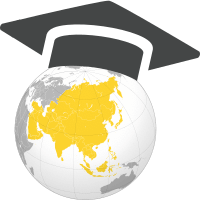Asian Universities World Representation
How many Universities are there in Asia in 2024? According to the uniRank database, which selects only institutions offering at least four-year undergraduate degrees (bachelor's degrees) or postgraduate degrees (master's or doctoral degrees), there are currently 6,278 officially recognized higher-education institutions in Asia. Considering that the uniRank database includes a total number of 14,013 officially recognized higher education institutions the proportion of Asian Universities in the world is as follows:
-
uniRank Asian Universities World Representation Index: 44.8%
Being the estimated population of the Asian continent around 59.8% of the total world population (source: United Nations' World Population Prospects, the 2015 Revision), the Asian Higher education system and offerings seem to be strongly underrepresented in the world at least in terms of the number of higher education institutions.
Public vs Private Universities in Asia
How many public and private Universities are there in Asia? Out of the total number of 6,278 recognized higher education institutions in Asia included in the uniRank database, 2,733 (43.5%) are public (i.e. officially affiliated to or run by national, state or local governments) and 3,127 (49.8%) are private. The type of control of the remaining Asian Universities included in the uniRank database is unknown or it has not been reported (6.9%).
In terms of the number of public versus private Universities, the uniRank database shows a slightly higher presence of private higher education institutions in the Asian continent as a whole. However, 151 (75.5%) out of the top 200 Universities in Asia are public higher education institutions. Differences and peculiarities may still exist in each Asian country's higher education system.
Non-profit vs for-profit Universities in Asia
What type of entities are Universities in Asia? Out of the total number of 6,278 recognized higher education institutions in Asia included in the uniRank database, 3,320 (52.9%) are non-profit and 306 (4.9%) are for-profit. The type of entity of the remaining Asian Universities included in the uniRank database is unknown or it has not been reported (42.2%). As a general rule, the vast majority of Asian public higher education institutions are not-for-profit organizations, not necessarily in legal terms but certainly in terms of nature and institutional purposes such as role, scope and mission.
Challenges for the higher education systems in Asia
What are the main challenges that higher education in Asia currently faces? According to uniRank the higher education systems in Asia face a range of challenges that affect both the quality of education and the ability of institutions to meet the demands of students and employers. Here are some of the key challenges:
a) Access and affordability: while there has been significant growth in higher education in Asia over the past few decades, many students still face barriers to accessing and affording higher education, particularly in rural or low-income areas.
b) Quality: while many universities in Asia are expanding, the quality of their education still varies widely. Some institutions struggle to keep up with advances in teaching and research, while others face a shortage of qualified faculty and resources.
c) Funding: higher education in some parts of Asia is often underfunded and many institutions struggle to find the resources needed to meet the demands of students, faculty and society.
d) Research and innovation: Asia is home to some of the world's most innovative and advanced research institutions, but many universities still face challenges in conducting cutting-edge research and translating that research into practical applications.
e) Technology: technology is rapidly changing the landscape of higher education and institutions that fail to keep up risk falling behind. Many universities in some Asian countries still face challenges in integrating technology into their teaching and learning, research and administrative functions.
f) Employability and relevance: Asian graduates of higher education programs sometimes face challenges in finding employment that matches their skills and aspirations. Many Asian countries are facing a skills gap, where graduates lack the skills that employers are looking for.
g) Internationalization: with increasing globalization, there is a growing demand for graduates who are globally competent and culturally aware. However, many Asian universities still face challenges in attracting and retaining international students and faculty, especially in those countries where English is not the chosen teaching language.
h) Harmonization: there is a lack of harmonization of the higher education systems in the Asian continent as a whole and most efforts of harmonization are limited to regional organizations and initiatives (i.e. ASEAN University Network, CampusAsia, etc.).
Addressing these challenges will require a concerted effort from governments, regional organizations and their programs for integration and mobility, universities and other stakeholders to invest in and reform higher education systems in Asia.
Top 200 Universities in Asia
uniRank publishes twice a year a non-academic university ranking of the top 200 Universities in Asia based on valid, unbiased and non-influenceable web metrics provided by independent web intelligence sources. Please read the ranking methodology on the About Us page for more information.

 Afghanistan
Afghanistan